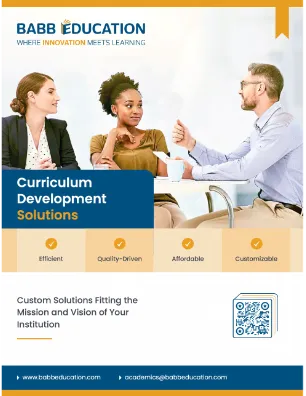Whether on campus or online, fostering a learning environment that encourages critical thinking, practical application of theory, and a sense of community is paramount.
Whether on campus or online, fostering a learning environment that encourages critical thinking, practical application of theory, and a sense of community is paramount. At Babb Education, we understand the intricate dynamics of online learning and are committed to helping faculty create transformative educational experiences. Our team of expert instructional designers collaborate daily with faculty to develop engaging discussion questions that achieve these goals. In this blog, we explore the significance of well-crafted discussion questions and provide insights into how they can be leveraged to enhance the online learning experience.
The Importance of Critical Thinking in Online Education
Critical thinking is a cornerstone of higher education, enabling students to analyze information, evaluate arguments, and develop well-informed perspectives. In his seminal book, The Art of Public Speaking, Stephen Lucas explains critical thinking skills include “the ability to distinguish fact from opinion, judge the credibility of statements, and assess the soundness of evidence.” Lucas also notes that critical thinking skills “make the difference between the articulate debater and the pushover, the careful consumer and the easy mark, the A student and the C student, and the thoughtful voter and the coin tosser” (Lucas, 2012).
In an online learning environment, where face-to-face interactions are limited, the role of discussion questions becomes even more crucial. Well-designed questions can serve as a catalyst for deeper thinking and intellectual engagement. When collaborating with faculty, Babb Education's instructional designers develop questions that push students beyond superficial understanding. By encouraging students to analyze, evaluate, and synthesize information, these questions foster the critical thinking skills vital for both academic achievement and practical problem-solving in the real world.
Bridging Theory to Practice
One of the primary objectives of higher education is to prepare students for the practical application of theoretical knowledge. However, bridging the gap between theory and practice can be challenging, especially in an online setting. This is where thoughtfully crafted discussion questions come into play. Our instructional designers focus on creating questions that encourage students to apply theoretical concepts to real-world scenarios. By relating academic content to practical situations, these questions help students see the relevance of their studies (a hallmark of adult learning theory) and develop skills directly applicable to their current and/or future careers.
Cultivating a Supportive Learning Environment
A supportive learning environment is essential for student success, particularly in online courses, where students may feel isolated. Engaging discussion questions can play a pivotal role in building a sense of community and fostering meaningful interactions among students.
Our team of experts help faculty design questions that not only stimulate intellectual engagement but also promote collaboration and peer learning. By encouraging students to share their perspectives, provide feedback, and engage in respectful debates, these questions help create a dynamic and supportive online classroom environment.
Best Practices for Crafting Engaging Discussion Questions
Creating effective and meaningful discussion questions requires a strategic approach. Here are some best practices that our instructional designers at Babb Education follow:
- Align with Learning Objectives: Ensure discussion questions align with the course’s learning objectives. Each question should have a clear purpose and contribute to achieving the overall course outcomes.
- Encourage Higher-Order Thinking: Design questions requiring students to engage in higher-order thinking processes such as analysis, evaluation, and synthesis.
- Promote Application and Reflection: Craft questions encouraging students to draw on their own personal and professional experiences, apply theoretical concepts to practical situations and reflect on their learning experiences. These types of questions help them bridge the gap between theory and application.
- Foster Collaboration and Peer Learning: Develop questions requiring students to interact with their peers. Encourage them to share their insights, provide feedback, and engage in constructive discussions. Providing response prompts is a great way to foster peer interaction.
- Use Open-Ended Questions: Open-ended questions allow for a range of responses and promote deeper thinking. They encourage students to explore different perspectives and develop well-rounded arguments.
Examples of Effective Discussion Questions
To illustrate the impact of well-crafted discussion questions, here are a few examples from our instructional designers:
- Business Management Course:
- "Choose three principles of strategic management and explain how they can be applied to address challenges faced by a startup company in its first year. Provide specific examples to support your argument."
- Psychology Course:
- "Explain the impact of cognitive dissonance theory on everyday decision-making. Share a personal or professional experience in which you faced cognitive dissonance and describe, in detail, how you resolved the situation."
- Environmental Science Course:
- "Choose and evaluate one local, state, or national policy aimed at reducing carbon emissions and suggest alternative strategies that can be implemented to achieve better results."
Include Response Prompts
Including response prompts is a powerful strategy for guiding students in constructing thoughtful and comprehensive answers to discussion questions. These prompts help students to structure their responses, ensuring they cover key aspects of the topic and engage in deeper analysis. By providing a framework for their answers, response prompts encourage students to think critically and articulate their ideas more clearly.
Here are three examples of effective response prompts:
- Explain how the initial post challenged your existing beliefs.
- Describe a real-world example supporting or challenging a learner’s position on a topic.
- Provide a link to research that confirms or disputes an initial post.
When prompts are written effectively, they challenge students to provide thorough and insightful responses while also encouraging them to engage with the material on a deeper level, enhancing their overall learning experience.
The role of discussion questions and response prompts in online education cannot be overstated. They are a powerful tool for enhancing critical thinking, bridging the gap between theory and practice, and cultivating a supportive learning environment. By collaborating with educators and leveraging our expertise, we ensure that discussion questions are not just a formality but a dynamic component of the learning process. Our goal is to empower students to think critically, apply their knowledge, and engage with their peers in meaningful ways. Babb Education is committed to helping faculty create meaningful and engaging discussion questions designed to transform the online learning experience for students.
Contact Babb Education today to learn more about how we can help you enhance your online courses with engaging discussion questions and response prompts. Together, we can create an enriching and transformative learning experience for your students!



